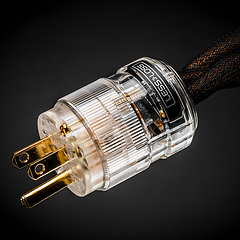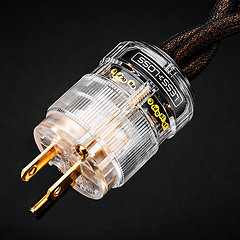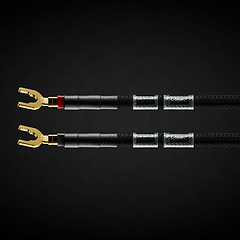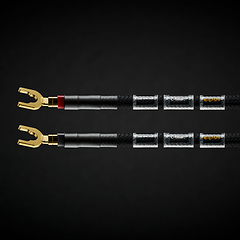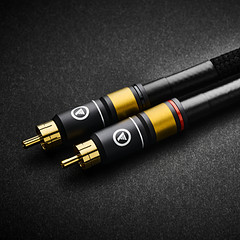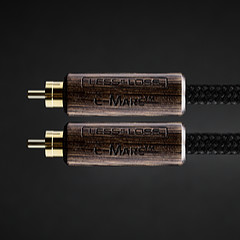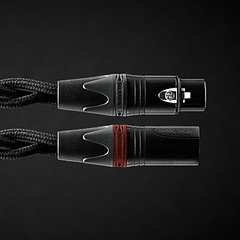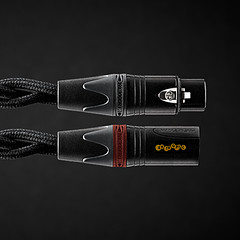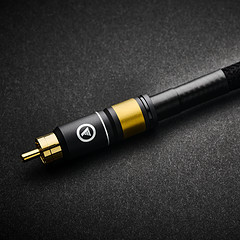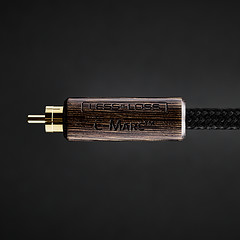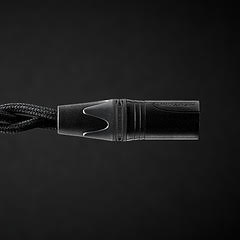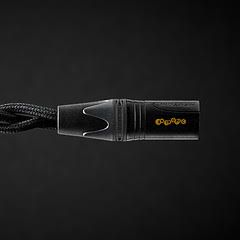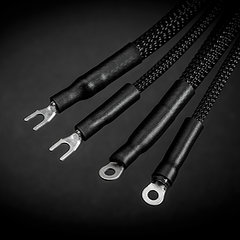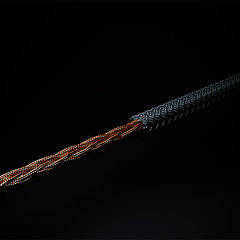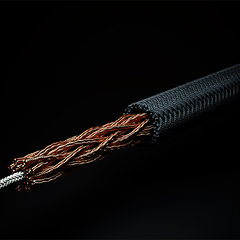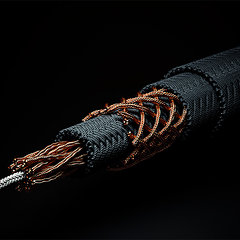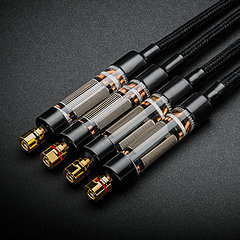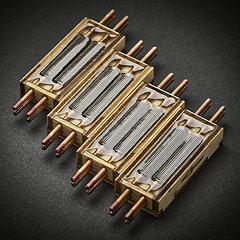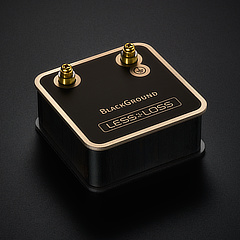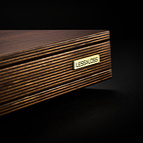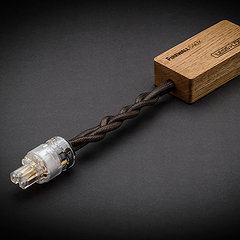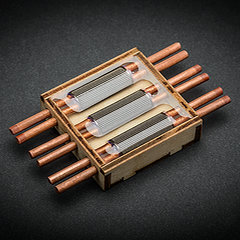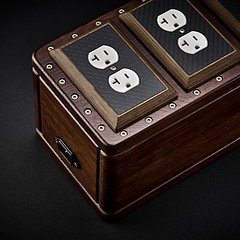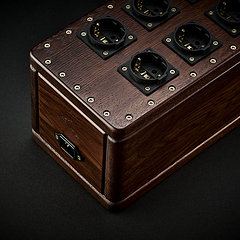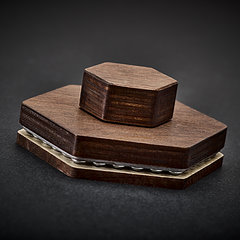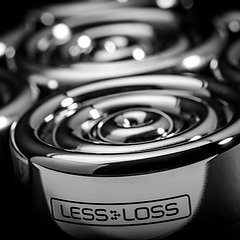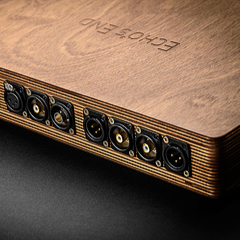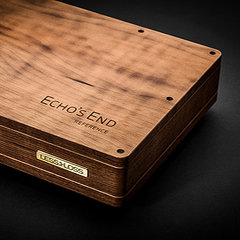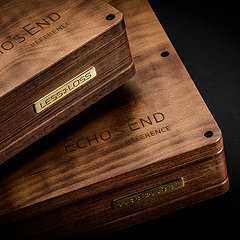
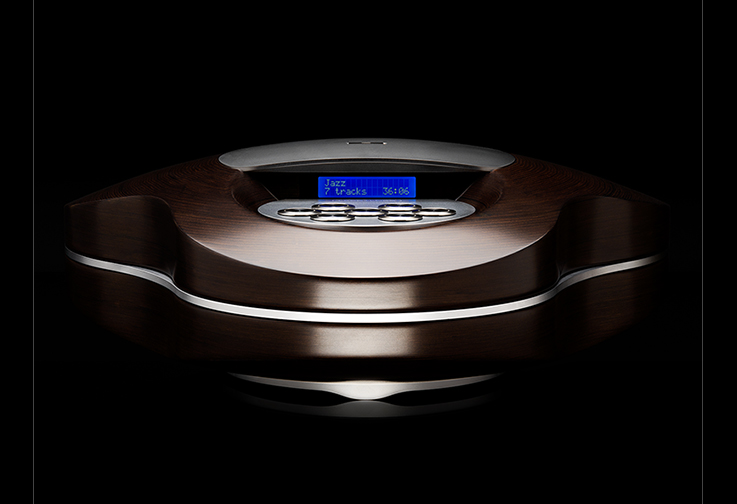
The all-new Laminar Streamer finally solves the problem of digital audio harshness by using only a single clock source for the formation of the pristine digital audio stream. Although the device plays .wav and .aiff files off of SD cards, LessLoss did not incorporate the use of Windows, MAC OS, or Linux for its operating system. Instead, from ground up, a dedicated audiophile operating system was built, streamlined for the specialized task of serving the topmost quality data while avoiding jitter. Unlike any other computer audio playback system, the Laminar Streamer's operating system runs synchronously at the audio sampling rate via the very same high quality audio clock used for the formation of the audio data stream. Thus, a new level of quality is achieved in digital playback, previously unattainable due to the inherent complexity of running an OS clock and an audio clock separately. The intricacies of asynchronous re-clocking, buffering, and jitter reduction have been solved at their very source, a world first for digital audio!
Purchase your Laminar Streamer here
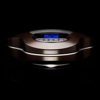
|
|
|

Free Worldwide express shipping.
Most deliver in 2-3 business days.
Main Features
Direct Drive SD Card Player
Plays any .wav or .aiff file from FAT32 formatted SD cards. About the size of a postage stamp, a Secure Digital High-Capacity (SDHC) card is a flash memory device that can hold up to 32 gigabytes (GB) of data. These cards are a form of removable memory that can be used with many different digital devices, including camcorders and computers.
44.1 kHz–192 kHz
Plays any standard sampling rate files, from 44.1 kHz through 192 kHz files.
16/24 bit
Plays 16 or 24 bit files at any standard sampling rate.
Instant SD Card Playback
Instantly recognizes the SD card. Boot time is less than 0.2 seconds. Nothing to configure, ever. No buffering, synchronicity, latency, or compatibility issues, ever. Nor viruses. Just plug and play the perfect audiophile stream, and keep your pristine audio off the noisy grid.
Essential Information Display
Small screen displays folder names, file names, sampling rates, absolute phase polarity, playback mode, and time.
Functions
Screen functions include: text scroll animation stop and Pure Laminar mode (screen off).
Phase Polarity Switching
On-the-fly 100% digital realm absolute phase polarity switching during playback.
Pure Laminar Mode
In Pure Laminar mode: screen data, active position monitoring, and back-light are all disengaged. The sole active operation remains Direct Drive clock-to-data pairing. The Direct Drive OS runs off of the active precision audio clock.
Playback Features
Playback features include: Pure Laminar mode, phase reversal during playback, repeat track, repeat folder, repeat SD card, play track and stop, play folder and stop, play SD card and stop, random track, fast forward while playing, rewind while playing.
Expansion Port
Optically decoupled expansion port for future remote control functionality without introducing any EM interference to the subtle audio streaming process. No onboard IR or Wi-Fi sensors.
Outputs
— S/PDIF output on RCA;
— AES/EBU output on XLR;
— I2S output on 5-pin connector.
Microvibration Control
Superlative microvibration control through precision milled solid steel and Panzerholz construction.
Dimensions & Weight
423.2×400×160.5 mm (16.66×15.75×6.32 inches), approx. 24 kg (53 lbs).
Great design celebrates the interplay between form, proportion, and function. At its core, the Laminar Streamer project could be described as a thorough execution of a fundamentally simple concept. Both its function and its appearance echo this same line of thought.
Digital music is often misleadingly described as brittle and edgy. This false accusation grew out of ubiquitous lackluster execution, both of electronic design, and of the related art of enclosure design. This dichotomy of 'electronics' and 'box' has remained an impediment to digital music's ultimate performance.
The Laminar Streamer manifests the very opposite — its oblique angles, organic flow of circular curves and overall sculpturesque form symbolizes the nature-like laminar flow of music, but not only to the eye. Its intricately positioned, interweaving, almost dancing curves form an organically shaped, yet simple, silhouette from any vantage point. This also holds true for internal vibration, from any angle of incidence.
Even though the Laminar Streamer serves digital data, it speaks the language of analogue, non-turbulent flow of fluids. The Laminar Streamer embraces emotional simplicity.
Laminar Streamer Development
LessLoss continues to strive to be one of the very best cost/performance values around. And our venture did not stop at power products. They represent the very core, the very foundation, to good sound. Then we introduced the Anchorwave and Tunnelbridge series of high performance signal cables to get that great sound from the gear to your speakers. But there has remained a bottleneck in terms of achievable sound quality from Digital which we will now tackle and address in the form of a new device which will take Digital to the next level:
Introducing the LessLoss Laminar Streamer
What does "next level" mean?
What the Laminar Streamer represents is the point of convergence of two lines of engineering which both have been establishing themselves over the years since 1982.
The first line - CDs, vibrations, and optics
1982 marks the date of the first compact disc technology to hit the market. Since then, compact disc players have become more and more refined, as audiophiles complained continually about harsh, digital sound (even if the measured noise floor was lower than that achieved by turntables). This technology brought about better and better physical solutions, with some exotic ones hitting the market which included air bearing drives (Switzerland) and belt drives with robust cases (Japan), precision tracks (Japan), blue diodes and plexiglass (France), extremely heavy top covers (Germany) and many others. With constant emphasis on ever more stabilization of the CD drive mechanism, these "monster players" evolved into giants to address some missing link in the CD reading and data streaming process. And, it must be said, much progress was indeed made in this realm.
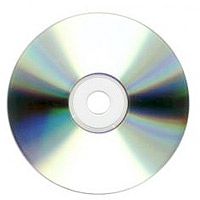
A bottleneck remained
However far the engineering had gone to bridge the bottleneck, still there were available countless tweaks to be carried out on CDs, to even further optimize playback. These included countless sprays, wipes, black and green markers, lathing machines, high lumen stroboscope conditioners, demagnetizing devices, ceramic ball ion blasting devices, many types of stickers, pads, and others. In fact, one audiophile friend of mine had pinpointed not less than 12 such tweaks which, carried out on discs before playback, each truly resulted in better playback, regardless which of the big players listed above were used. So, evidently, some sort of bottleneck remained, and it seemed to be confined to the optical and vibratory realm.
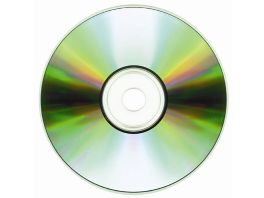
Furthermore, many an audiophile had discovered by then that taking the time to use freeware ripping software (Exact Audio Copy was very popular shareware) and to re-burn the discs onto CDRs of different types would result in different sound quality from the original (notably, black and dark blue CDRs were known to provide superior sound quality). So there was obviously an element of Jitter entering the stream which was dependent upon the optical realm and was not getting re-clocked out of the auditory realm completely. The tweakers' saga continued, regardless of whether the re-clocking was synchronous or asynchronous, and whether the transport was master or slave to the DAC.
Enter Computer Audio
Because so many audiophiles were now experimenting with burning their own CDRs, it was only inevitable that many would discover the sound quality of listening to their ripped CDs directly from their computers as well. With the advent of the iTunes craze and other even higher quality sound files (24/96 for example through HDTracks), as well as the growing ease of downloading such high-res files and the impossibility to play them back on Redbook CD machines, computer audio was quickly becoming the next big thing. The internet was getting faster by the day.
There developed two schools: one was made up of independent, almost underground, tweakers of desktop computers. More and more was invested in the development of USB as a viable alternative to S/PDIF to reach external DACs from the computers, the reason being that more computers came fit with USB straight from the mass-production factories than those equipped with S/PDIF outputs. (There was a $2888 USB to S/PDIF converter which comes to mind as an indication of how more and more quality could be cajoled out of USB by crossing over to S/PDIF with smart clocking techniques, for USB is a clockless protocol in essence).
Another school was betting on the Firewire protocol (Switzerland comes to mind). Still others were going all out with stand-alone computer audio solutions, with tweaked up professional sound cards and desktop PCs meant for the otherwise mass market of number-crunching machines for the most various of applications (Korea and USA come to mind).
Regardless of the computer audio solution, one general tendency, one line of convergence, was clearly discernible all the while.
Removing services
Because these operating systems were enormous (Windows and MAC computers are meant to be universal to the point of sharing processing power even with hidden viruses and malware), it became clear through sonic tests that the audiophile tweakers gained considerable ground by disabling services, and the more, the merrier. As audiophiles delved deeper and deeper into their office computers, they found that there are a plethora of limiting factors in terms of enabling a digital stream to flow completely in laminar fashion, without Jitter. Here is a list of some such limiting factors:
-- High speed processors contaminate the entire circuitry and ambient field with radio frequencies and higher. The higher the frequency, the harder it is to keep other parts of the circuitry from being contaminated by them. (Resistive surface tweaks such as conductive lacquer or carbon fiber / nickel paper proved very effective here.)
-- PC motherboards feature many, many more functions which we don't need at all. Each are powered and run at high frequencies which clutter the entire circuit, which reduce sound quality of digital audio streams, where timing is the only qualitative factor (and the easiest to pollute because it is so fragile and crucial).
-- Video cards and other sections of the motherboard have radio frequency oscillators which further contaminate the environment. They run at high frequencies and intermodulate with the audio sampling rates we need.
-- Mouse, keyboard, USB, Firewire, IR, disc drives, video, ethernet, wi-fi and other synchronization software are running and require many parts which need power. Even more crucially, these elements all compete with the CPU for processing time. The key here is the time.
-- CD ripping software must run (well, not during playback), but all the CD ripping functionality must exist in the motherboard. Wires are dangling in the unit to connect the CDR/DVD burner/reader tray. Each wire is an antenna, and further clutters the atmosphere. Busses of loose wire run high data rate information between the internal components such as storage devices.
-- Fans are often necessary to cool the CPU. Acoustical noise results. Electrical noise results as well.
-- Computer operating systems are extensive and require many services, which all compete for processing time. These processes are allocated according to what are called priorities. It is known through the world-wide consensus of experienced computer audio tweakers that the more services you can disengage, the better the resulting audio. The stream becomes more laminar, less turbulent. Several companies have built entire businesses out of turning off the very services that the audiophile user knows or didn't even know that he had in his household computer. With highly lightened operating system services, these mass-produced office computers are re-branded as specialized audiophile music servers. Still, any connection to the Internet can result in a faulty system, with viruses lurking everywhere.
-- There are memory allocation issues at all times in the operating system of a computer. In high end audio we need extreme silence of operation and 100% perfect time allocation, meaning we need all of the CPU's attention at all times for no jitter to appear. We can't share the individual clock steps with other functions which the computer deems just as relevant for its operation. We want full quality, which means we need the whole clock to ourselves for the sole purpose of the creation of the audio stream alone.
-- There are really many clocks: one for the CPU, one for video, one for the audio card and other functions, and they all interfere with one another due to RF interactions and through the power supplies. This atmosphere is not made for real-time streaming events. It is made for calculation and error-checking, and for being fast at it. You can rip a CD at 52x speed and get 100% data accuracy. Data accuracy is not at all an issue in any computer these days. Timing accuracy is our realm as audiophiles, and home PCs are not suitable environments for the kind of high end audio we wish to achieve.
The list goes on and on, and so the idea for the past 15 years or so in computer audio has been to strip the operating system of all services at every step that they are yet able to do this. This represents the second line of convergence into the Laminar Streamer.
Two lines of convergence point to one solution
To sum it up, here is a list of the strengths and pitfalls of both lines:
Lineage #1: optics-based solutions
Pros:
- very simple operating systems
- no viruses ever, plug and play functionality
- the romance of putting it into the machine to play it
- psychology of "Albums" is maintained physically
Cons:
- microvibrational influence on sound quality magnified
- expensive, massive physical realm solutions
- Redbook CD going out of style
- High-res DVD Audio / SACD war has been surpassed by ease of download
- numerous optical tweaks reveal obvious bottlenecks of performance
Lineage #2: solid state solutions
Pros:
- absence of optical components
- download capability
- storage media becoming cheaper by the day
- cloud storage (safer backup) on the horizon
Cons:
- plethora of operating system services competing for clock time
- overall system complexity due to non-dedicated engineering
- clock sharing bottleneck regarding Jitter performance
- power supply issues remain just as important as before
- numerous operating system tweaks reveal obvious bottlenecks of performance
A question for LessLoss Audio:
Can we get the best of both worlds into one machine? By doing so, can we circumvent all of the cons of both approaches?
Yes, we can!
The Laminar Streamer SD card player!
Just to make sure you know what an SD card is, it stands for Secure Digital and looks like this:
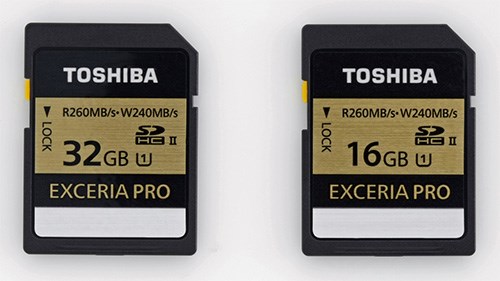
More info is available here:
http://en.wikipedia.org/wiki/Secure_Digital
They are getting cheaper, larger in size, and more efficient in their access procedure. Read speeds of up to 260 MB/sec are now available in Japan. This technology will spread across the globe next.
The Laminar Streamer has been developed by LessLoss from the very ground up, without using any modules or ready-made operating systems available for other purposes (Linux, Windows, etc.). In it, we have created the conditions for the ultimate audio stream to be formed directly from the audio clock. To understand the uniqueness of our solution, consider this:
The audio sampling frequencies available today are as follows:
44.1k / sec (Redbook)
48k / sec
88.2k / sec
96k / sec
176.4k / sec
192k / sec
What you can see from the above list is that there are actually two base frequencies, namely 44.1 and 48, which are multiplied by two and three times. Hence, the list is made up of two main frequencies and their whole-number multiples.
For a perfect stream to form, we need the data to be associated with a running audio clock. This is the only function the operating system should have. Everything else will demand processor time, and, hence, will introduce tiny deviations in the perfect timing we need.
What we have managed to do is to create our own audio dedicated operating system which functions exactly off of the very audio clock. This means that when the operating system is functioning (boot time and SD card recognition is less than 0.2 seconds), the data read off of the SD card is directly coupled to the clock's wavefronts and that is all. The stream is the result of 44,100 such operations per second. And this stream is very close to flawless in the time domain.
When a file is to be played which needs, say, a 48 kHz clock, this is then no longer possible with the original 44.1 kHz clock we used for the 44.1k file before. The solution most computer operating systems use to solve this is an extensive array of clocking functions, each running at different speeds and through what is known as PLLs (Phase Locked Loops) which introduce Jitter into the stream. However, the solution is easier in an engineering sense because only one clock is necessary for all of the different frequencies listed above. You can "round out the clock ticks" to get to the frequencies you need. But this "rounding out" probably need not be discussed here with you. Of course, it results in "that harsh digital computer audio sound".
Instead, what we have done, is have engineered a completely synchronous operating system itself. When a 48k file needs to be played, the 48k clock is turned on and the 44.1k clock is turned off, and the operating system itself begins running off of the new active clock. This is done seamlessly and in no time. No clicks or pops result in the digital stream. This seamless functionality and operating system's tight hold on both the clock and data streams are what make this system unique. Any file of any sampling frequency can be played right after one another, without the sloppy desktop computer CPU operations averaging out the clock speeds to make this work. Whereas an office PC is good for fast operations, we need not that. We need perfect timing operation, something which is not foreseen in the big operating systems.
The Laminar Streamer will be compatible with any sound file which ends in either .wav or .aiff and which was brought onto the SD card by either a PC or MAC computer. Folder names will be created by the user on their own office PC or MAC. We do not want people to have to pay for office computer functionality using their audio money! Let the mass-production world take care of that. We'll take care of the stream, the perfect timing needed to get so deep into your digital recordings, you'll completely rediscover everything you've ever heard in digital.
Compatibility will be with any DAC which has S/PDIF, AES/EBU, or even I2S input (pin configuration to be announced). Use any DAC you like the sound of. Best results will be when the DAC's asynchronous re-clocking is disengaged. The one-clock streamlined system is then maintained. The further quest for quality will then be reduced to the quality of the power provided to both the Laminar Streamer and the DAC in use together with it.
Of course, design wise, we are going to provide something very special. We want the listening experience to be beautiful, but also the domestic visual experience as well.
If the digital stream is laminar, truly laminar, then the largest influence of quality has already been met, and true appreciation of the musicianship and all of the higher content truly present in the recordings can much more readily be experienced.
Join our Newsletter List
We look forward to serving you with more info about the new Laminar Streamer as it becomes available. We are sure that the divorce of the office PC from the listening station will be an attractive alternative to the invasive information overload we already experience in our everyday lives, and will help bring back a tranquil serenity and meditative aspect to our private listening chambers. We will be so close to our beloved artists and their messages that it will feel only natural to take pause from our emails and other office routines.
More Information Only via Newsletter
We have been posting the latest information about the new Laminar Streamer on our Newsletter. You can see the latest posts here:
LessLoss Newsletter Archive
Please, subscribe to our Newsletter by adding your email address to our list. You'll get the latest information when it becomes available.
We recommend this excellent video about digital audio conversion
If you believe that PCM audio, even the good old "Red Book" 44.1 kHz sampling rate, has deficiencies, and are struggling to understand all the intricacies of the modern day "format wars", we highly recommend you watch this informative video, which shows that there are no deficiencies in PCM audio encoding and conversion, nor have there ever been. The only frontier remaining is the ever lowering of Jitter content, but the protocol and conversion is and always has been spot on.
The Laminar Streamer with its unique Direct Drive OS sounds interesting. But what kind of DAC will deliver the best performance with it?
There are two types of DAC chips on the market: the parallel resistor 24-bit ladder technology, and the 1-bit Sigma-Delta technology. In our opinion, having built this device:
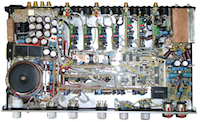
in order to directly compare four DAC chips head-on, using the exact same conditions of operation for each, we came to the conclusion that the parallel resistor ladder DAC technology sounds better.
A frequently asked question:
I do not understand how I would get a high quality version of a CD onto an SD card. I understand that I can get a CD drive and use my lap top and some sort of program to get it onto an SD card- but won't it be terribly ruined by then? Isn't my computer/USB cable much worse sounding than my transport? How can perfect playback make up for damage done getting it onto the SD card? Wouldn't a CD drive IN the Laminar Streamer be a better sonic solution?
Answer:
On an Apple computer, on Finder, you just "drag and drop" the music files from the CD to the SD card. Once they are on the SD card, you now have exact digital copies of the data which is on the CD. No loss of quality occurs because at this point there isn't an issue of quality. Instead, at this point it is an issue of avoiding digital errors (data mistakes). But once you commence digital playback, which is a real time process, then you are dealing with quality and avoiding Jitter in real time (small timing errors).
That's why the Laminar Streamer is a separate device, because playback is the only realm where quality is at stake. Getting the digital data onto the card is not going to affect its quality, provided there are no data errors.
One can take 100 computers and 100 copies of any CD, and copy those CDs to 100 SD cards, then send the data from the cards to 100 different servers in 100 different countries, then return them all to a single computer, compare all the files against each other, and you'll find they are all bit perfect copies. Error checking copying algorithms are robust. It is an office procedure.
So no worries on the office end of things. That is not where quality lies. The concept of quality in digital playback applies only during playback.
Another frequently asked question:
I think I follow but why doesn't a transport (much more stable than my computer's external CD drive) that feeds a digital buffer create an ideal output as the buffer has no moving parts? I have used a buffer and it gave a slight improvement over the transport directly, but only when the buffer had its own power supply and was on special feet. Does your method differ from a buffer in some essential way?
Answer:
Yes, our method differs in a HUGE way. Consider this: the most advanced buffer in the utopian world is the one that has an infinite distance from the source, an infinite buffer size, and absolutely no tie with the original power supply nor any vibrational associations at all from the source. This is achieved in our solution by the user physically taking his hand and removing the SD card from the computer, bringing it physically from there to the Laminar Streamer, physically inserting it into the Laminar Streamer, and thus achieving absolutely perfect separation from all of the above contributions to poor sound from digital.
We borrow this action from the world of analogue playback and apply it to digital. We bring the digital bits right up into the Laminar Streamer just as one brings the record grooves right up to the needle, by hand.
What you say about your experience with buffers shows that it is only on a theoretical level that buffers can make deleterious effects in the data chain inaudible. There have been many companies with many products claiming perfect digital transfer, all of which have gone under, or at least whose products have subsequently been discontinued. You can still hear improvements, as you say, such as through power supply tweaks, vibration control changes, digital cable changes, etc.
Question:
Will the Laminar Streamer play SDXHC?
Answer:
Maximum size supported is 32GB FAT32 formatted SD cards. This is for streamlining of operation and minimizing internal noise in the unit's circuitry.
